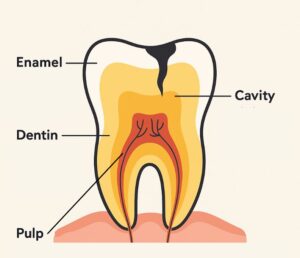You might not care about a quick pain when you drink something cold or a dull ache that goes away after a day. But if you notice minor symptoms more often or they become harder to ignore, they could be early signs of bigger dental problems. Many oral health problems start with minor changes, like cavities and swollen gums. If you know what to look for early on, you can avoid greater pain later.
This guide explains which warning signs should never be overlooked and what to do if they appear. At WestLake Dental VA we scan and treat cavities daily, if you suspect you have a cavity don’t wait! Book an appointment with us today!
Persistent Tooth Pain Isn’t Normal
Tooth pain that lingers for more than a day or two is often a sign that something deeper is happening. While it’s easy to hope it will fade on its own, dental discomfort rarely resolves without attention, and the longer it’s ignored, the worse it can become.
Some warning signs to watch for include the following:
- Sharp pain when chewing may point to a cracked tooth or a deep cavity.
- A dull, throbbing ache, often caused by inflammation or infection inside the tooth or gum.
- Pain that radiates to the ear or jaw may indicate a spreading abscess or pressure on nearby nerves.
- Intermittent pain that returns, signaling early nerve exposure or decay that’s worsening over time.
What Does a Cavity Look Like? Early Signs to Catch Before It Gets Worse
Cavities often begin with subtle changes that are easy to overlook. Due to mineral loss, the enamel may appear chalky white in the earliest stage. As decay progresses, darker spots may occur, ranging from light brown to black, especially in the grooves of molars or between teeth. 
Some signs to look for include the following:
- White or light spots on the tooth surface signal weakened enamel.
- Brown, black, or gray areas, particularly hard-to-see areas like the back teeth, indicate weakened enamel.
- Visible holes or pits, which indicate more advanced decay.
- Sensitivity to sweets, cold, or heat can be observed without visible damage.
Not all cavities cause pain, especially early on. That’s why visual signs and routine exams are essential. If any of these changes are noticeable, it’s time to book a visit with us today before the damage goes deeper.
Signs of a Gum Infection
Specific changes in your gums can signal more than just irritation; they may indicate a severe infection or an issue beneath the surface. Swelling, bleeding, and pus each point to specific problems that require attention.
Swelling
Localized infections or chronic inflammation often cause gum swelling. This can occur around a single tooth or across a larger area. If the gums appear puffy, tender, or red, especially if there is no improvement after brushing and flossing, an underlying infection may be the cause.
Bleeding
While occasional bleeding may occur during first-time flossing, frequent or spontaneous bleeding should be taken seriously. If left untreated, it may point to gingivitis or periodontitis, leading to gum recession and tooth loss.
Pus
The presence of pus around the gums or between teeth is a clear warning sign of infection. This often accompanies a metallic taste, foul odor, or increased pressure in the affected area and requires immediate dental evaluation.
Don’t Ignore the Signs: Protect Your Oral Health
If you notice any of the symptoms mentioned above, don’t wait. Early attention can prevent a simple issue from turning into something more complex. At WestLake Dental VA we offer fast and affordable treatment for cavity screening and cavity fillings. Book an appointment below!


